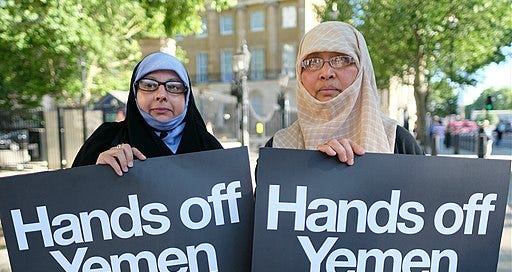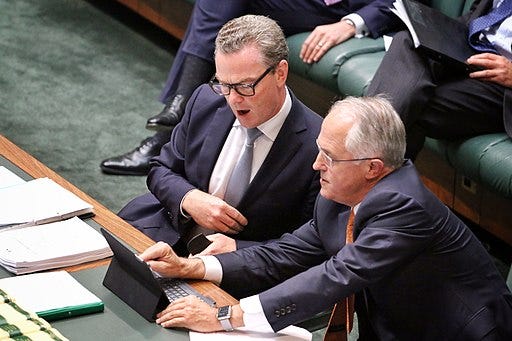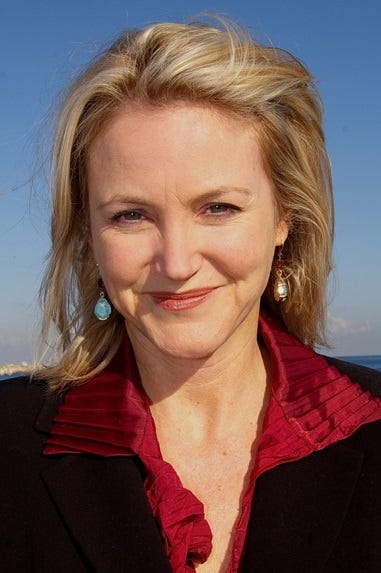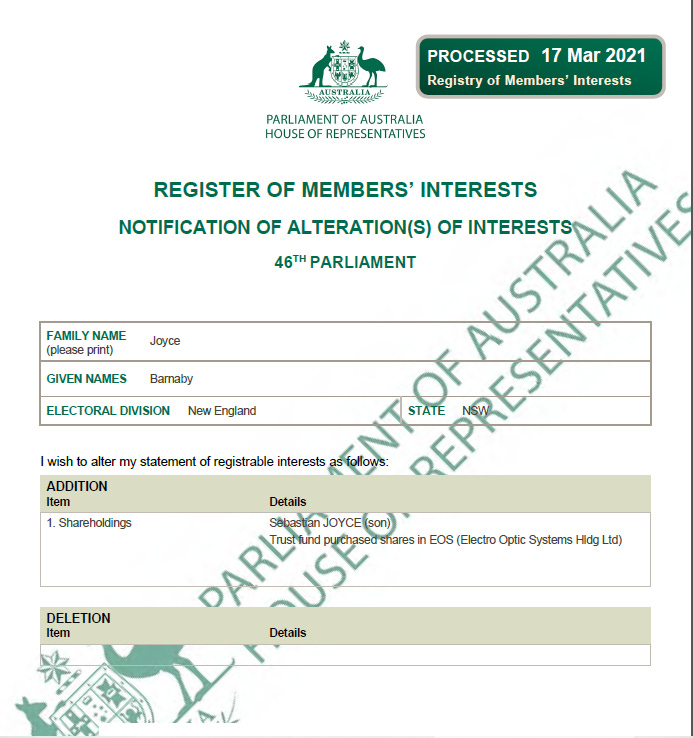“You’ve got to … get your hands covered in blood if you want to be one of the big 10” was the warning for Prime Minister Malcolm Turnbull when he announced Australia’s goal to become a top global weapons exporter.
“[You’ll]…be selling to Saudi Arabia, to the United Arab Emirates…to these very authoritarian countries…engaged in major conflict…in places like Syria…in Yemen. You’ve really got to get your hands dirty.”
That warning came from Andrew Feinstein, one of the world’s foremost experts on the arms trade, interviewed on ABC radio in early 2018.
He was soon proved correct.
Australia had already been doing secret arms deals with the countries fighting the catastrophic Yemen war, despite large numbers of civilian casualties and mounting evidence of war crimes. News of the deals emerged publicly in late 2018: Australia had approved dozens of military export permits to Saudi Arabia and the United Arab Emirates (UAE), the key nations fighting in Yemen.
By March 2021, Australian military export approvals to these two nations had topped 100: eighty to the UAE, twenty-three to Saudi Arabia.
Australia’s Yemen war
The ongoing Yemen war is now widely known to have caused the world’s biggest humanitarian catastrophe. But even as early as October 2016 the UN was warning of likely war crimes and calling for nations to stop supplying weaponry to the countries fighting there: “Since the beginning of this conflict in Yemen, weddings, marketplaces, hospitals, schools—and now mourners at a funeral—have been hit, resulting in massive civilian casualties and zero accountability for those responsible.”
The world was aware of the horror being inflicted on Yemeni civilians by the Saudis and the UAE by the time Christopher Pyne, as Australia’s new defence industry minister, flew to both countries in late 2016 to spruik Australian weaponry.
Just months later, Pyne returned to the UAE for further talks. While in Abu Dhabi, he attended the Middle East’s largest weapons expo, the International Defence Exhibition and Conference (IDEX). Pyne said he was discussing a possible $1 billion worth of arms deals with the UAE, adding that Australian companies could finalise hundreds of millions of dollars in sales at IDEX 2017.
His prediction came to pass when, in early 2018, Canberra-based weapon-maker Electro Optic Systems (EOS) announced a $410-million contract with an unnamed customer for EOS’s remote weapons systems. The secret customer was later exposed as the UAE, and the deal size increased to $450 million. In October 2017, Pyne again flew to the Middle East, for more meetings in Riyadh.
Launching Australia’s arms export strategy
Late January 2018. The day after Prime Minister Turnbull launched Australia’s arms export strategy, trade minister Steve Ciobo said he was not concerned that exported arms might one day be turned against Australia.
“This isn’t about providing weapons or arms to rogue regimes or anything like that,” he told breakfast television. “We’ve got strict controls, and those controls make sure we only supply defence assets in the future to like-minded countries that have a strong human rights record and have protections in place.”
That statement was plainly false. Ciobo had led a trade delegation to Saudi Arabia in April 2017 that included representatives from the ‘defence export’ sector. His colleague Pyne had already concluded arms deals with Saudi Arabia and the UAE. Like-minded countries? Strong human rights records?
As to Ciobo dismissing the possibility of weapons being turned against Australia, his confidence was misplaced. He noted later in the interview that Islamic State (ISIS) was “a major problem”. A three-year investigation undertaken by Conflict Armament Research in fact found that US-supplied weapons had frequently ended up in the hands of ISIS in Syria and Iraq. The investigation also found that the United States “repeatedly” contravened agreements with its EU weapons suppliers and diverted the EU-manufactured weapons to opposition forces in Syria, and that ISIS subsequently gained custody of significant quantities of them.

Cosying up to repressive regimes
In August 2018, a Saudi-coalition missile strike on a school bus in Yemen killed forty children and eleven adults and injured dozens more. Despite this atrocity, the Australian government wanted to get closer to Saudi Arabia and the UAE.
The following month the Saudi assistant minister for defence visited Australia and attended one of Australia’s largest weapons expos, Land Forces. Pyne had just been appointed defence minister.
During Land Forces 2018, Pyne said Australia was looking at signing new formal ‘defence industry’ agreements with the UAE and Saudi Arabia. It was startling news that Australia was considering locking itself into arms-supply arrangements with these two repressive regimes.
In October 2018 the question of arms sales to Saudi Arabia erupted as a global issue. The gruesome murder and dismemberment of journalist Jamal Khashoggi inside the Saudi consulate in Istanbul dominated headlines for weeks. On this subject, Australia’s new prime minister found a moral voice. “We are appalled beyond description by what has happened,” said Scott Morrison.
Pyne’s plan for a defence industry agreement with the Saudis was suddenly ‘not a priority’. The proposed agreement with the UAE ceased being mentioned. Asked in July 2021 whether Defence has made progress with these agreements since October 2018, a Defence spokesperson said, “Australia does not have defence industry agreements with either Saudi Arabia or the United Arab Emirates.”
In the wake of Khashoggi’s murder, Foreign Minister Marise Payne said “all options are on the table” when asked whether Australia would follow the lead of several European countries and stop exporting weapons to Saudi Arabia. Defence Minister Pyne said future military exports to the Saudis would be assessed with regard to the “deplorable” events. Both ministerial statements simply provided a policy holding pattern.
The Lowy Institute’s Anthony Bubalo commented at the time, “We do need to look very, very closely at the issue of defence exports to Saudi Arabia. We should have been looking…at that anyway, not because of what happened to Jamal Khashoggi but because of Saudi Arabia’s continuing involvement in the war in Yemen, which has been a humanitarian disaster.”
Meanwhile, Pyne tried to distance himself from the Saudis by perpetuating the myth that Australia can dictate what Saudi Arabia does with Australian-supplied weapons.
Pyne was reported as saying that strict export controls “prevent” our equipment being used in the ongoing conflict in Yemen. But Australia’s “strict export controls” can prevent no such thing. In weapons deals with Saudi Arabia or the UAE the only point of strict control is the decision on whether to approve the export. If we want to be strict, Australia can say, ‘No’. Once an export is despatched, the chance of Australia exercising control over how those weapons are used plummets to virtually zero.
Under intense questioning in Senate hearings in 2018, defence department official Tom Hamilton could not categorically rule out the possibility of Australian weapons being used in Yemen. He admitted, “Military equipment, by its nature, will contribute to the capability of a military force and will often contribute to a conflict.”
Hamilton also noted that Defence assesses arms exports on a “case-by-case basis” and “consider[s] all relevant current information around the likely use of the item that’s been exported”. He repeated the usual line that Defence will not approve an export permit if it’s considered likely that the weapons would be used to contravene international law.
This blinkered case-by-case approach leaves unaddressed the overarching question of whether Australia should, in the first place, be enhancing the military capacity and weapons arsenals of nations already known to be serial and significant human rights abusers.
“Australia has a legal duty under the UN Arms Trade Treaty, which Australia actively promoted when it was a UN Security Council member, to ensure that weapons are not used to commit human rights violations,” says former Australian politician and international lawyer Melissa Parke, who is now one of the UN’s group of experts on Yemen. “Under the treaty, there must also be fully transparent public reporting about arms exports.”
What happened to ‘transparency’?
In the 2018 Senate hearing, Hamilton noted that Defence was working on “a framework for transparency of defence exports”. What became of this?
A Defence spokesperson said in July 2021, “In the 2018 Defence Export Strategy, the Government committed to enhance the transparency of defence export control principles and approach, including public reporting of defence export approvals and denials as defence exports grow.”
The spokesperson did not include an equally relevant sentence from the strategy that reads, “This will provide the Australian public with increased visibility of equipment and technology exports…” (italics added).
The visibility of actual exports has not increased at all. The Australian government continues to refuse to provide any details about the nature, quantity or destination of Australia’s arms exports.
The spokesperson also said, “Data relating to export permits is published quarterly on the Defence website.” At the time of writing, Defence had not yet published data for the March or June quarters of 2020–21. [Since this story was first published the data has been updated - Ed.]
The data on the Defence website is broad brush, with several complicating factors identified but not addressed, thus obscuring any meaningful picture of Australia’s arms exports. Despite the government’s strategy declaring the Middle East a ‘priority market’, there is no data at all showing the value of arms exports to this region and whether, or by how much, they have increased.
In a 2020 report examining the Defence Export Strategy, the auditor-general said Defence had not established baseline data for defence exports or a methodology for measuring them. Defence responded that developing a baseline was a complex undertaking and that a suitable evaluation framework would take several years to implement. It has already been several years since the strategy was launched.
Would we ever find out if Australian weapons had been used in Yemen? Probably not. There is no formal Australian system in place to monitor arms exports. What does this say about our ‘strict’ controls that ‘prevent’ Australian weaponry from being used in Yemen, or anywhere else, in contravention of international law?
Feinstein told ABC radio:
Our governments do not monitor that equipment once it’s been delivered to Saudi Arabia. And it’s for this reason that we find elements of Al-Qaeda, elements of ISIS, and ISIL operating in Syria, operating in Yemen, even operating in Iraq, who are armed with United States, British, and probably Australian weaponry.
Feinstein’s concern about the lack of formal monitoring by governments is borne out by responses from another defence department official under questioning in the Senate:
Senator Ludlam: How do you provide for protection and confidence that Australian military exports will not be used to…further human rights abuses inside Yemen?
Ms Skinner: Because where we have a concern that that will occur, we do not issue the permit.
Senator Ludlam: How do you ensure, after the gear has left our shores, that is not happening?
Ms Skinner: We have other ways of monitoring, where we can, through intelligence and other things, where we might understand munitions are used. We do not track Australian goods and companies per se, but should there be at some other point a concern, we would add that to our base of information. (Italics added.)
As this 2017 exchange makes clear, Defence does not track Australian weaponry or companies after export has been approved. But what does the rest of Skinner’s response mean in practice?
Illegal weapons transfers
Governments routinely attach end-user certificates to military exports that prohibit the retransfer of the weapons to third parties without approval. Despite this, unauthorised third-party transfers occur regularly. The United States diverting EU-supplied weapons into Syria without authorisation, mentioned earlier, is an example. There are rarely any repercussions for offending nations.
A German public broadcaster partnered with the Jordan-based Arab Reporters for Investigative Journalism in 2018 to investigate weapons transfers into Yemen. The investigation found, “No penalties have ever been levied for breaching end user agreements.”
During the year-long investigation, Egyptian journalist Mohamed Abo-Elgheit uncovered hundreds of examples of weapons and military vehicles supplied by Germany, the United States, the United Kingdom, Austria, Switzerland, Belgium and others either being used in Yemen by al-Qaeda and other non-state armed groups or offered for resale, still brand new, on the black market. Western governments had sent the weapons and equipment to Saudi Arabia and the UAE with ‘strict’ end-user agreements in place, supposedly preventing transfer to third parties.
The investigation found:
armoured vehicles supplied to the UAE and Saudi Arabia by the United States being used by non-state armed groups (one later added to a terrorist watch list) in Yemen, some draped in UAE flags. The United States said it would investigate.
large armoured vehicles the United Kingdom had supplied to Saudi Arabia were also found in use by armed groups in Yemen, one being driven by a known fundamentalist Islamist leader. The UK government refused to engage with the journalist, saying the investigation was politically motivated.
Germany initially claimed it would investigate breaches, but, when provided with serial numbers and photographs of German weapons for sale on the black market, it stopped responding to the journalist.
the Austrian government did not respond to evidence of hundreds of its rifles supplied to Saudi Arabia being used in Yemen, some by children, others for sale in markets.
Swiss grenades supplied to the UAE were filmed in the hands of Yemeni fighters. Switzerland said it would investigate.
Does the Australian government have a greater ability than any of these countries to exert control over the Saudis and the UAE as to how Australian weapons and other military exports are used? Can Australians trust bland assurances from the defence department that Australia’s ‘strict export controls’ prevent the illegal use or transfer of Australian weapons?
On this issue of trust, in October 2020 an Australian-made transponder was discovered in a downed Azerbaijani military drone used in the latest eruption of the long-running conflict between Azerbaijan and Armenia over Nagorno-Karabakh. The Queensland manufacturer of the transponder, Microair Avionics, said it did not sell them to Azerbaijan. So how did its transponders end up in Azerbaijan’s drones? The company refused to reveal the country to which it had sold the transponders. The Departments of Defence and Foreign Affairs and Trade also refused to answer any questions. Within months of our investigation being published, Microair Avionics had revamped its website, having removed key information.
Revolving doors and “upmarket mercenaries”
EOS has attracted significant criticism in recent years for its decision to supply its weaponry to the UAE and Saudi Arabia. In a startling and mixed review of EOS’s financial position, The Australian Financial Review reported in June 2021 that the UAE accounts for 60% of EOS’s total revenue (adding that the revenue is being booked by EOS as it manufactures the weapons, not upon delivery).
In a statement issued to the ABC when its supply of weapons systems to the UAE was exposed, EOS used an ‘economies of scale’ argument to defend its decision: “Foreign sales significantly reduce the cost of development, acquisition and support for Australia for defence technology. This is the principal reason why Australian industry participates in international sales”.
In March, the company’s UAE subsidiary signed a partnership agreement with the UAE to develop a high-tech machine gun.
The company receives solid support from both major political parties.
Along with Pyne’s joint sales trips to the Middle East with the EOS chief executive, the ‘revolving door’ has proved useful. The EOS board includes former Australian chiefs of army and air force Peter Leahy and Geoff Brown and former ALP senator Kate Lundy. Brown and Lundy are also current members of the ACT Labor government’s defence industry advisory board and both act as ACT government ‘defence ambassadors’. The ACT government has granted EOS significant tax concessions and has repeatedly refused to answer questions about them.
Earlier this year, Barnaby Joyce, now Australia’s deputy prime minister, disclosed that a trust fund established for his three-year-old son owns shares in EOS.
In January 2019, Defence Minister Pyne flew to the UAE to meet with its de facto leader, Crown Prince Mohammed bin Zayed, along with its minister of state for defence.
Pyne’s media release didn’t mention it, but documents released under freedom of information reveal that his visit included a meeting with former senior Australian army officer Michael Hindmarsh, who is now the commander of the most important military unit in the UAE armed forces, the Presidential Guard, which was closely involved in the Yemen war.
In a 2018 piece for Arena on Australia’s links and involvement with Yemen, Richard Tanter describes Hindmarsh’s 2009 transition from senior ADF commander into “up-market mercenary” for the UAE government:
Hindmarsh retired from the ADF as a major general in June 2009 after a career in the Special Air Service Regiment (SASR), serving in Afghanistan and Iraq and as head of the Special Operations Command.
During much of his later ADF career Hindmarsh was closely involved with the UAE, mainly through his role in the expansion of the large, longstanding Australian base at Al Minhad Air Base in Dubai. …
Hindmarsh initially accepted a position in late 2009 as national-security adviser to the UAE’s de facto leader, Crown Prince Mohammed bin Zayed, and shortly after as commander of the UAE’s Presidential Guard, reportedly at a tax-free salary of half a million dollars a year. In this role, Hindmarsh is a member of the UAE’s armed forces, wearing a UAE lieutenant general’s uniform and, most importantly, reporting directly to bin Zayed.
There are reportedly dozens of former ADF personnel working with or as part of the UAE armed forces, including a number of senior former officers whom Hindmarsh brought with him.
While heading Australia’s Special Operations Command, Hindmarsh served under Lieutenant General Peter Leahy, then the chief of army. Leahy is now chair of the EOS board, having joined it in May 2009, less than a year after he retired as army chief.
Flouting international law
After the launch of Australia’s Defence Export Strategy, Pyne gave a commitment that Australia would only authorise military exports to countries “like ourself who support the rules-based international order”. He’d broken this commitment before he even made it. Or, to put it more plainly, he lied.
On top of extensive documented breaches of international law in Yemen by Saudi Arabia and the UAE, and the murder of Jamal Khashoggi by Saudi Arabia, the UAE is widely known to be illegally arming and supporting rebel Libyan forces trying to overthrow Libya’s internationally recognised government, in defiance of a UN arms embargo. Following repeated breaches over many years by multiple countries, including the UAE, the UN has labelled the embargo “totally ineffective”.
Regardless, Australia has continued selling weapons and other military equipment to the UAE and Saudi Arabia.
“Australia’s actions in approving arms exports to countries that are known to be committing serious violations of human rights, and its failure to be transparent about this, are inconsistent with its obligations under international law,” says Parke. “Having signed up to…these international laws, the Australian government can’t just cherry pick what aspects it’s going to abide by, especially when it…lectures other countries, such as China and Russia, about the importance of the international rule of law.”
Is there another way?
Nearly 2.3 million children under the age of five in Yemen will suffer acute malnutrition this year and 400,000 could die if they do not receive urgent treatment, said UNICEF in February.
Save the Children Australia coordinates the Australian Arms Control Coalition, a group of human rights organisations (including Amnesty International, Oxfam Australia and the Medical Association for Prevention of War) calling on the Australian government to stop exporting weapons to Saudi Arabia and the UAE.
Save the Children says 1.71 million children are in displacement camps in Yemen, and 90 per cent of these children don’t have sufficient access to food, clean water, or education.
“Yemen is the world’s worst humanitarian disaster,” says Philippa Lysaght, humanitarian policy and advocacy adviser at Save the Children Australia. “To think that Australia is somehow complicit in this catastrophic war is horrifying. It is time to stop the war on children.”
Bruce Riedel from prestigious US think tank The Brookings Institution has called the Yemen war “America’s war”. He says Barack Obama could have stopped the war right at the start in 2015 by cutting off military, diplomatic and intelligence support for the Saudi-led coalition. Riedel notes the huge proportion (86%) of Saudi Arabia’s weaponry supplied by the United States and the United Kingdom and says, “It is time to stop the carnage in Yemen and stop fueling the arms race in the Middle East.”
America’s loyal ally Australia should do the same.
Arms-trade campaigner Ann Feltham is succinct: “The arms trade fuels war, exacerbates regional tensions, gives succour to human rights abusers, and squanders resources.”
Earlier this year, Australia confirmed it would not ban arms sales to Saudi Arabia and the UAE.
Important questions remain unanswered: what does this murky trade with repressive regimes have to do with the defence of Australia? Why is Australia willing to be associated with the deaths of tens of thousands—maybe hundreds of thousands—of children, and to stain its international reputation just to provide a comparatively small number of Australians with jobs of questionable morality?
Surely there is another way.
This feature was first published in Arena Quarterly No 7 , Sept 2021







